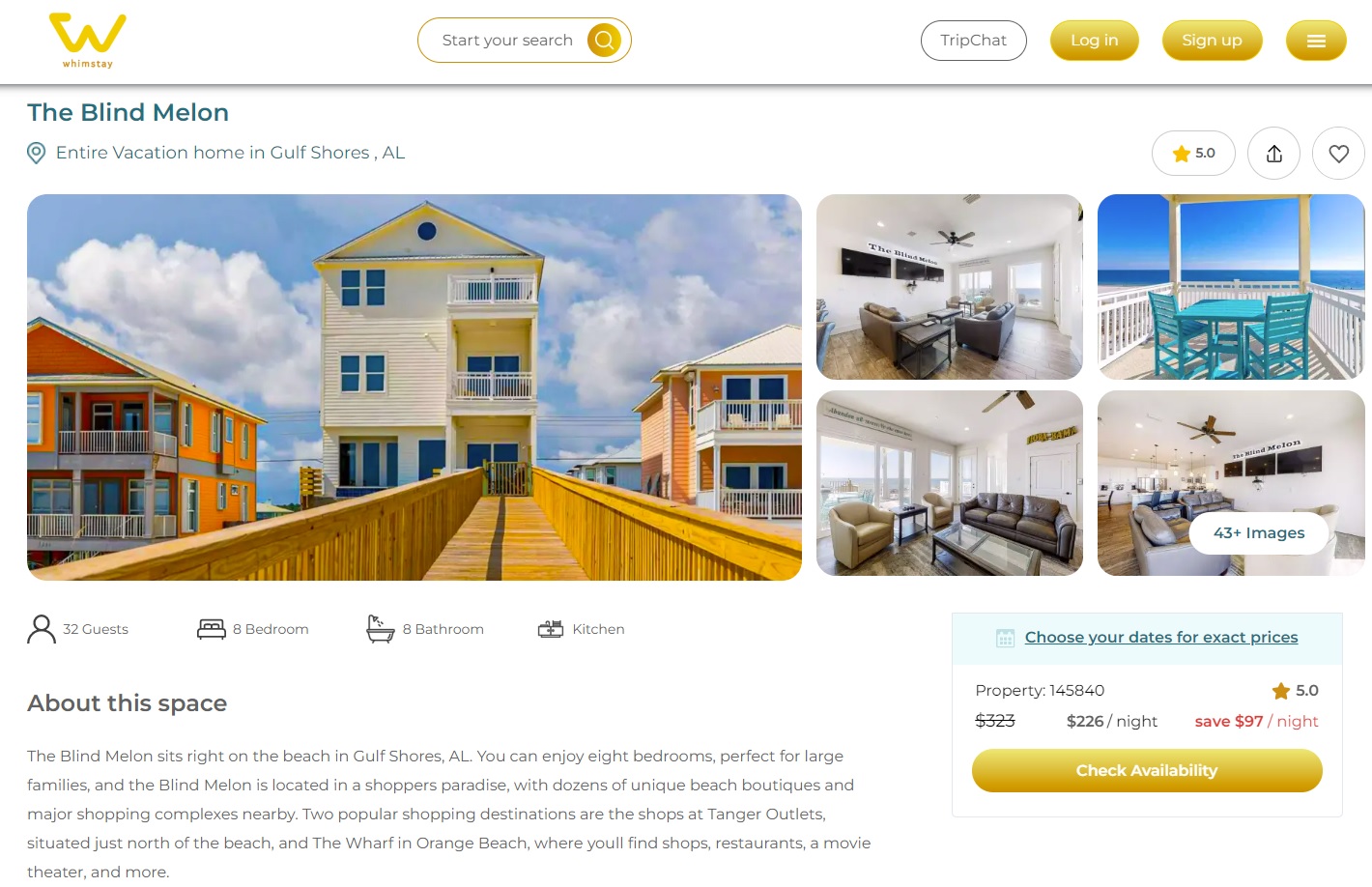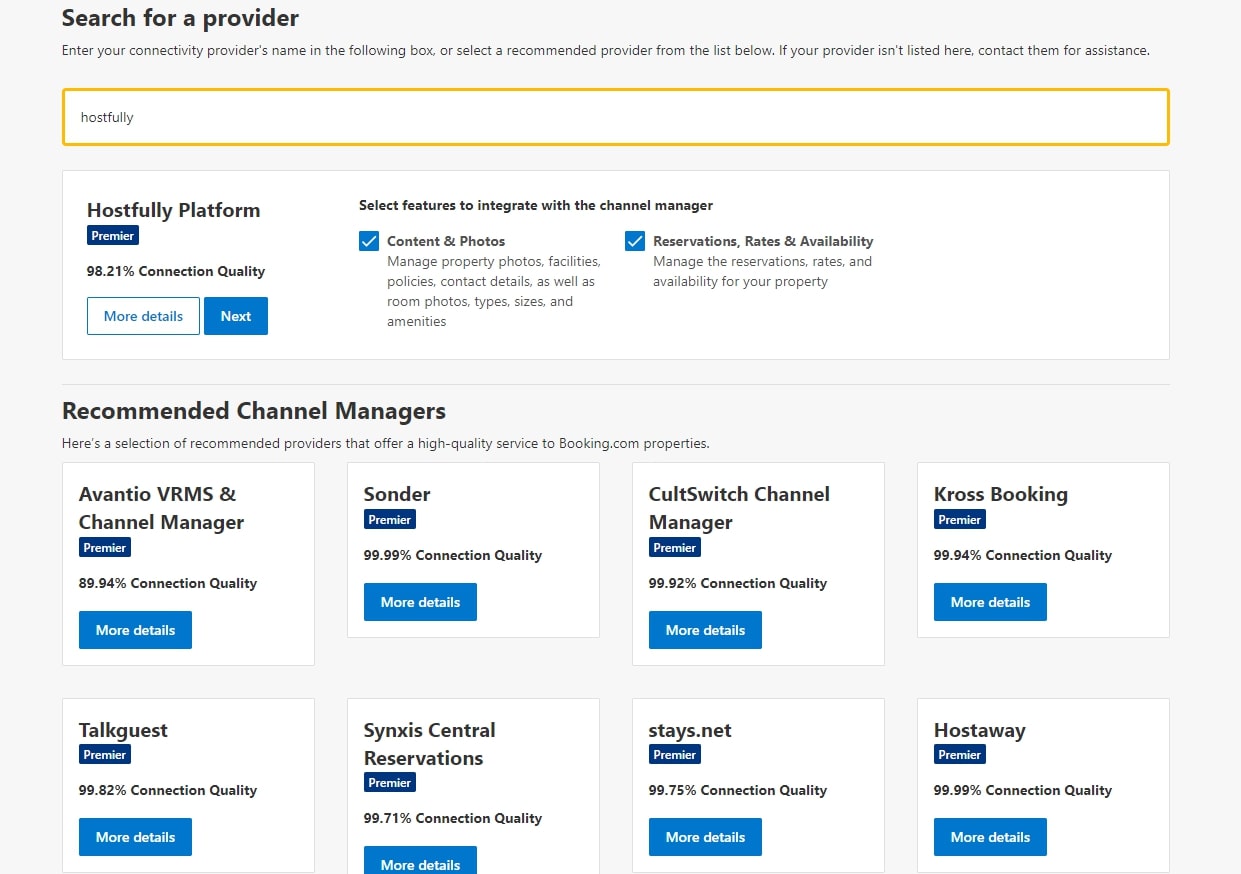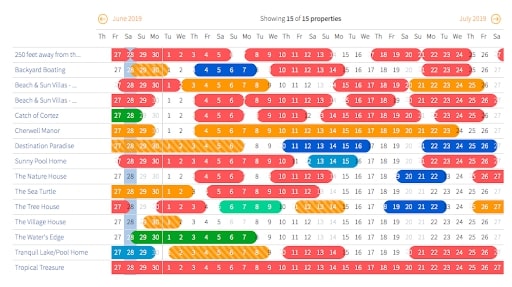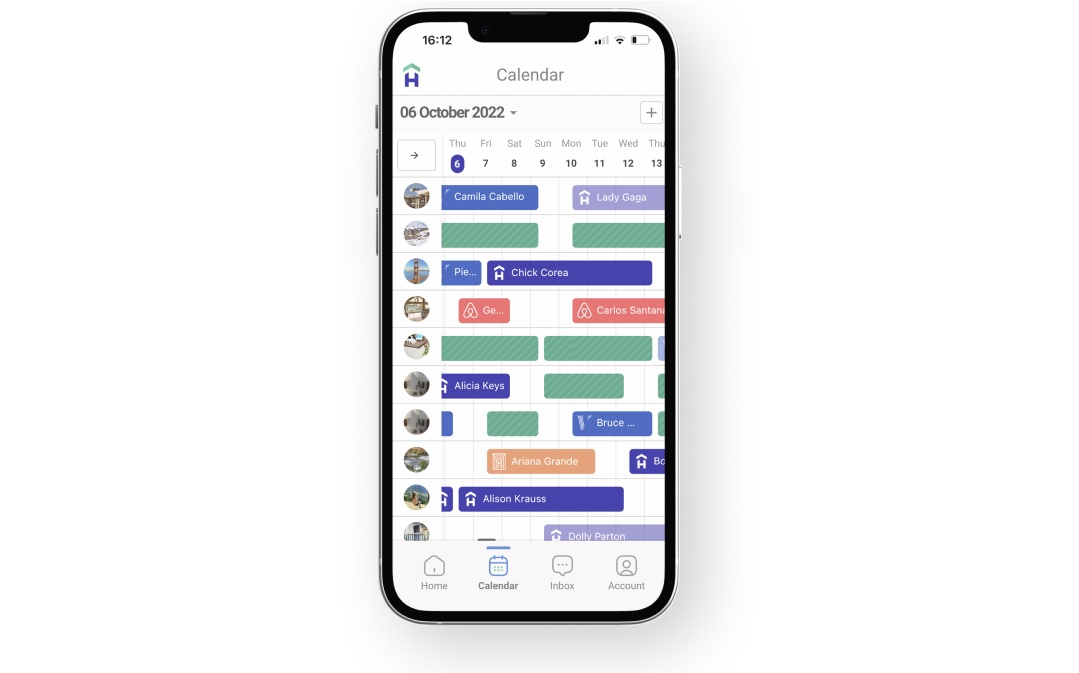Sticking to just one booking channel can leave serious money on the table for your short-term rental properties. It could even put your business at risk.
Listing your vacation rentals on multiple channels means more people are likely to see your property, and it’s more likely to get booked. It’s that simple.
But managing multiple-channel distribution effectively is a lot to juggle.
You don’t want to spend hours manually tweaking individual sites, ensuring availability and rates are up-to-date across booking platforms every day, or losing track of who booked from where. And that’s even before you consider the nightmare of accidental double bookings.
Fortunately, you don’t have to manage it all manually. There are some tried-and-tested ways to make your multi-channel management more effective—with less time and stress. Using a property management platform system with dedicated channel management features is a major way to streamline and automate the entire process.
And we’re here to help. We’ve explored:
- Why you need multi-channel distribution for your vacation rental properties
- Our 6 recommended steps to manage and list vacation rentals on multiple channels
- Our 7 extra tips to manage multi-channel listings without spending hours on manual admin
- How many channels are best when it comes to listings
- Some great ideas for more niche sites to try
Why you need multi-channel distribution for your vacation rentals
It’s simple: You need to stop relying on one single channel or website (such as Airbnb or Vrbo, for example) for your vacation rentals.
The most successful, largest companies are listed in multiple places. In fact, Hostfully research has found that 65% of all property managers with 100+ properties list on major sites like Airbnb, Vrbo and Booking.com BUT also on search aggregators such as HomeToGo, Booking.com, and Tripadvisor (compared to only 15% of smaller companies with 99 properties or fewer).
Here’s why.
More channels, more visibility, more revenue
The most obvious reason to list on more channels is that it hugely increases the chance of your listings being seen and booked. More eyeballs on your properties mean a greater chance of a booking, meaning higher occupancy and revenue for you and your owners.
Popular channels attract millions of guests and many more views for your listings.
Recent research by Hostfully found that Airbnb’s website has an average of 94 million visitors per month worldwide, while Vrbo and Homeaway have 40 million and Booking.com has a whopping 600 million. That’s a lot of potential guests and credit cards lining up to see your listings and book a stay.
More ideal guests
Listing on multiple channels means you can attract your ideal guests more easily. This is especially true if you list on more niche sites. The big hitters such as Airbnb, Vrbo, and Booking.com are great, but the competition there is incredibly high and search terms are often very broad.
Instead, you can target more niche accommodation sites—such as professionals looking for medium-term stays, parents with young children, travelers with pets, digital nomads, or people looking specifically for hiking cabins. This gets your listings in front of your ideal guests and lets you niche down to offer exactly what they’re looking for.
Your guests will likely have a better stay because your property will be particularly tailored to their needs, and you’ll get better reviews and more bookings.
Less reliance on one channel
Relying on a single channel is the vacation rental equivalent of putting all of your eggs in one basket. This puts your business in a very vulnerable position and hands control of your visibility over to a single company.
A quick Google for “Airbnb algorithm” shows more than 2.4 million results, with most of the top results focusing on stories of people “freaking out” about website changes. The worry is that if an algorithm or platform changes significantly, your rentals may stop being seen by would-be guests, and your main source of bookings could disappear.
Relying on an algorithm on a single platform means that you’re at the whim of unexpected online travel agent (OTA) changes, no matter how excellent your rentals. It also means that if your listings are accidentally banned, reported, or delisted, you could lose all of your business overnight.
Instead, listing on multiple channels spreads those rental eggs across baskets. So if one breaks, you’re not all out of yolk luck.
Advertising done for you
As an individual host or property manager, you can have the best advertising campaign possible, and it still won’t reach the numbers (or level of sophistication) of the big channels, which spend billions getting it just right.
In the first nine months of 2022, Airbnb spent $1.1 billion on “sales and marketing” combined, its financial filings show. Advertising spend like this can get the word out incredibly effectively. The more channels, the more advertising dollars go towards getting views on your listings, without you having to directly pay for or manage any separate marketing.
6 steps to manage and list vacation rentals on multiple channels
Now you know why let’s dig into how to successfully list on multiple channels.
1. Research channels
The first step to successful multiple-channel management is to research the channels most suitable for your business. Of course, you’ll likely want to target big names like Airbnb, Vrbo, Booking.com, and TripAdvisor to ensure maximum reach.
But you may also want to niche down by location, activity, or guest type. This will help you design your rentals to appeal perfectly to a specific type of guest or highlight any extra facilities or advantages your properties have over others.
You should also take into consideration where your guests travel from. In their home country, there might be one platform that’s more popular than others. For example, HomeToGo is a popular site in Germany and other northern European countries. So a North American vacation rental operator that gets reservations from those countries should also consider listing on HomeToGo to drive even more bookings.
With fewer rentals and more tailored audiences, niche channels and marketplaces help you to stand out as a bigger fish in a smaller pond, boosting your bookings.

Source: Whimstay.com
For example:
- Homes & Villas by Marriott International – Luxury rentals curated by the global hotel brand
- HomeToGo – A vacation rental brand that lists everything from houses to castles and boats
- getawayGoGo – Last-minute rental deals with discounts, special offers and cancelation rates
- VacayMyWay – A site aiming to simplify vacation rentals, with clear fees and communication
- RedAwning – A members-focused hub of more than 15,000 rentals across 1,000 destinations
- Homads.com – A site for fully-furnished, single-family long term vacation rentals of at least a month, designed for people who are considering relocation
- YonderVacationRentals.com – A collection of luxury vacation rentals near the great outdoors
- Whimstay.com – A vacation rental website especially designed for last-minute stays
- FindRentals.com – An aggregator that enables guests to find a rental, and book direct
2. Create accounts
Once you’ve decided which channels to use, you’ll want to create accounts on each. This can be done on each individual channel and, depending on the site, you may have to pay for a login or host account.
Different listings channels will have different fee structures or charges for listings.
For example, it’s free to register on Airbnb as a host, and it costs nothing to fill in your property details, upload photos, set your availability, and list your rates. You only start paying once bookings are confirmed.
Some channels or marketplaces, such as Kid & Coe, for example, require you to apply to join, and offer extra benefits to members. As another example, Florida Rentals is free to sign up for and is currently offering new listings a 60-day free trial, but then charges a flat fee of $249 per year.
3. Get validated
As part of your sign-up process, you’ll want to get validated as a host, if the site or marketplace offers such an option. For example, Airbnb offers a validation process that requires you to submit a government ID for approval to boost trust and security.
The more validation you display via your listings or channel profile page, the more you build rapport and trust with potential guests. This is especially important for ‘new’ hosts or listings on a site, as your page will not yet show any positive reviews or previous stays (another way to build trust).
Getting validated gives would-be guests a better impression, and boosts the chances of them booking.
4. Set up payment processing
Even if you’re not yet taking direct bookings via your own vacation rental website, you’ll need to set up vacation rental payment processing, so you have some way of accepting money for your rentals. Most websites will have a section in which you can specify how you’d like to be paid.
Most will ask you to input bank account details, Stripe credentials, or a PayPal address, to name just a few possible options. Each of these may require you to set up a separate account (for example, to accept payments via Stripe and PayPal, you’ll need a Stripe or PayPal account), but these are usually fairly quick and easy to do.
Depending on the site, your payment processing may vary. Some will pay you on a regular schedule, some will transfer money as soon as you receive it; others may require you to transfer your funds out of the platform to a separate account.
However you want to do it, setting up payment processing is key to getting paid for your properties.
5. Create your listings
Some might call this the “fun bit!” Here’s where you get to showcase your properties to the full and shout as loud as you can about their advantages, amenities, excellent location, etc.
Crafting the perfect listing and optimizing it to show up in search results and convert is an art form. See here for some more great examples of vacation rental listings.
Some key points to remember include:
- Use high-quality, bright photos of your rental. Ensure it’s tidy, clean, and well-lit. Professional photos could even be a good investment here. Include wide shots and close-ups of rooms, amenities, views, and facilities, so guests can see exactly what’s on offer.
- Title your listing descriptively and clearly. Highlight a specific amenity, standout aspect, or fun things to do in the area to stop guests scrolling and get them clicking on your listing. Free up space by avoiding repeating what they likely already know (for example, the city the rental is in). For example, you might say “bright, arty loft in multicultural Kensington Market” rather than “2-bed rental in Toronto”.
- Include detailed lists of the amenities and facilities. Guests want to know what they’re buying, what’s included, and what they do and don’t need to bring. Making sure your amenities are properly set up will also have a big impact on your search visibility. Listing site search algorithms try to connect users with what they are looking for. So if you’re leaving anything out, you’ll miss out on all those searches. Double check that your amenities are fully checked off.
- Answer any frequently-asked questions, so guests have all the main information they need before they even book.
For example: How will they check in? What transportation do they need to get there? What if their flight is delayed? What if they want to check out late? Where can they store their luggage? What kind of air conditioner do you have? Is there a coffee machine? What is there to do in the area?
The more questions you can answer in your listing, the more guests trust you and start to imagine themselves at your property, and the more likely they are to book with confidence.
Once your listings are complete, make sure they’re published, visible, and bookable, so you can move on to the next step.
6. Sync with your PMS
The final step is to connect your PMS to your channel accounts. The exact process to sync your PMS with your channel listings will depend on the channel. To do this, you’ll need your client key or agency ID key from each listing site.
Once you have that, enter it into your PMS on the integration page. For example, in Hostfully, go to the Integration page in your dashboard and search for the channel you want to connect to.
Then follow the steps and copy the key from the channel into the PMS.
After you’ve followed the steps to link your external accounts and your PMS, you should receive confirmation from your listing channel that everything is ready to go. You can then start taking bookings and syncing across platforms.

Syncing listings with your property management system (PMS) has two major advantages. Firstly, you can update your listings from one central platform in minutes, saving you hours of laborious, manual site-by-site updates.
Secondly, you can sync your calendar and update availability across all channels. This ensures that your guests always see the latest rates and availability—and you avoid the nightmare of double bookings.
Hostfully also lets you factor in site-specific fees and commissions using the Channel Rate Multiplier.
7 more tips to manage multi-channel listings
Want to maximize your reach across even more channels and manage your listings even more effectively? Try these tips:
1. Use a channel manager
A channel manager can be a tool that comes with your PMS or a dedicated third-party tool designed to help you get maximum reach.
You’ll want to check that your channel manager feature in your PMS covers all the major channels you need, can connect to a range of portals via an API, and has the integrations you need across payment portals, insurance, and other third-party tools.
You’ll also need to check that your PMS offers connectivity via a robust API rather than iCal. APIs sync updates in real time whereas iCal doesn’t always do this. That means you may have short periods where information is inaccurate on one channel, including availability, which can lead to double bookings.
See here for more on the benefits of APIs.
If you do decide to connect to even more channels via a third-party network, you need vacation rental software that integrates with it (such as Hostfully with NextPax and Rentals United, for example). This will help ensure your listings reach as many niche sites as possible.
2. Raise your rates
The more channels you list on, the more bookings you should get and the higher your occupancy rates will be. This then lets you consider raising your rates.
When you raise rates, occupancy may initially drop slightly. However, you’ll be earning more per stay so this–plus increased bookings overall thanks to your multi-channel distribution strategy–should compensate for lower occupancy.
Using a dynamic pricing tool can also help you get the most competitive rates for your rentals by taking into account factors like demand, occupancy, number of bookings, seasonality, etc. Use this data to inform decisions about whether to raise rates. Hostfully integrates with leading dynamic pricing tools on the market, including Rented, Nightpricer, DPGO, Wheelhouse, PriceLabs, and Beyond to help you always get the best rate.
3. Use a multi-calendar
A multi-calendar enables you to manage multiple listings and bookings in a single place. You can pull bookings from across channels and see what’s booked up and when.
This helps you to not only keep track of your vacation rental business in a single dashboard but also enables insights such as which properties are most popular and when each property needs cleaning before the next guests arrive.
Most good PMSs offer a centralized calendar with color-coded tapes to help you identify different bookings across multiple properties more easily.

4. Use a centralized inbox
A centralized inbox, often also called a unified inbox, helps you to manage communication far more effectively than attempting to keep track manually across various apps and inboxes.
The best PMSs will enable you to bring together communication from direct booking guests, Airbnb texts, SMSs, and email, so you never miss, forget, or lose a message.
Many will also enable you to filter and sort, schedule messages with crucial information such as check-in details, as well as create templates and pre-send emails, so you can manage all chats from the same place—regardless of the booking channel.
Good PMSs will also have automated messaging features so you can pre-schedule important details on the same platform. This means your guests will never be left waiting for important information, you’ll never forget to send check-in details or ask for a review, and you can stay responsive even while you sleep.

Source: Hostfully.com
5. Use a direct booking site
Paradoxically, one of the most effective ways to support your distribution across multiple channels is to set up your own direct booking website. This enables you to build your own brand, save on OTA and listing fees, foster better relationships with guests, and drive more repeat bookings.
Many would-be guests who use various listing channels may search for your brand outside of the platform to check you’re legit and research your reviews. So having a separate, direct, well-branded, and fully functioning booking website is crucial to build trust and boost revenue.
Good PMSs will enable you to connect your direct website bookings to your wider vacation rental management setup. So the same principles of a centralized calendar, updated rates, and unified guest messaging still apply.
A direct website also enables you to own your platform away from the changing whims of OTA algorithms, and establish vacation rental listing independence. So you can get a significant percentage of your bookings without relying on external channels at all.
6. Get a PMS with a mobile app
A major way to simplify multi-channel management is to use a platform that offers a mobile app for on-the-go property management and super-responsive communication.
The best apps will enable you to see your calendar, with all bookings visible—plus details about each guest and reservation. This means you can keep track of multiple platforms and incoming messages from wherever you are, whenever you need to, with no risk of missing anything.

Source: Hostfully.com
7. Use a team task management tool
The more channels you have, the more likely you are to have bookings coming in fast and furious from several different sites.
Make this potentially-complex situation easier by investing in a PMS with team access coordination. So you can delegate tasks, changeovers, maintenance, and management of properties with ease.
Team access tools enable you to grant team members permission into certain areas of your back-end systems so they can access properties, carry out tasks, and help you manage what could otherwise become an unwieldy, multi-channel, multi-staff operation.
8. Collect guest data
Collecting guest data means you can market your properties in future and encourage direct, repeat bookings. This also reduces your dependence on listing sites and saves on OTA fees.
Once you have a guest’s contact details, you can also send them offers, special treats, or other incentives to book direct.
PMSs such as Hostfully, or alternatives like Hostaway and Guesty make capturing guest data easy, no matter which channel they originally used to book. You can then keep track of all stays, enable rebookings in a few clicks, run marketing campaigns to your new lists, and generate demand even during low season.
How many channels should you list your vacation rental on?
You should list your vacation rentals on as many channels as possible, provided they help you connect to your ideal guests and bring in bookings.
Plus, if the channel or site has an upfront fee (rather than taking a percentage of each booking), the number of bookings you get from it should be worth the investment.
For example, Tripadvisor and Airbnb take around 3%, Booking.com takes 15%, and Vrbo/Homeaway take 5%. Vrbo also offers the option of a $499 annual fee, which may work out as cheaper than a pay-per-booking model, depending on your revenue.
These fees should be factored into your rental rates and overall business budget.
There are three kinds of distribution channels, and the kind of rentals and services you offer may also determine which ones will work best for your business.
- Vacation rental listing platforms – Specialized marketplaces that list rentals. Includes Airbnb, Vrbo, and HomeAway.
- Online travel agencies (OTAs) – Marketplaces that offer rentals, experiences, transportation, and packages. Includes Booking.com, Expedia, and Tripadvisor.
- Meta and search aggregators – Marketplaces that don’t manage listings themselves but gather rentals and offerings from others. Includes Trivago and HomeToGo.
Multiple booking channels: the key to vacation rental success
Listing your vacation rentals on multiple channels expands your reach, maximizes bookings, and boosts your revenue. It also helps you to attract more ideal guests and reduces your vulnerability to listing platform algorithms.
But effective vacation rental property management takes coordinating all channels without overwhelm, confusion, or long hours of manual work. This means researching different channels for your business, choosing niches that will work, creating attractive, targeted listings, and syncing with a powerful PMS.
Distributing your listings via multiple channels is much easier to manage via a PMS like Hostfully that facilitates day-to-day property management.
For example, Hostfully also enables you to connect to a third-party channel manager and manage communication and bookings via a unified inbox and central calendar. It also helps you to coordinate and automate team tasks, and leverage guest data for future marketing from anywhere thanks to the mobile app. It also lets you create an attractive direct booking site or embed a booking engine in your own site to boost fee-free bookings.

Source: Hostfully.com
Frequently asked questions about multi-channel vacation rental listing
What is multi-channel listing for vacation rentals?
Multi-channel listings for vacation rentals is where hosts or property managers place their property listings on various websites. These may include listing platforms like Airbnb and Vrbo, OTAs like Booking.com and Expedia, or meta aggregators, like Trivago. Multi-channel listing can help increase your reach and boost bookings. Managing this is much easier if you use a property management system such as Hostfully.
What is the best way to list my short-term rental?
The best way to list your short-term rental is to ensure it appears on multiple channels, so you can expand the reach and secure more bookings. You may also stand out better if you list on more niche sites, specific to location, activities, or types of guests. You can also ensure your short-term rentals are well-managed and stand out well with an attractive direct booking website and property management platform (PMP) that coordinates all channels.
What are the benefits of listing on multiple channels?
The benefits of listing on multiple channels include more revenue, more ideal guests, less reliance on one channel or its algorithms, and advertising with better reach. You can maximize your reach by researching the best channels for you. Using a property management platform can also help by enabling you to list on more channels easily, updating listings from a central dashboard, and reach more potential guests through more niche sites too.
Should I list my vacation rental on Craigslist?
Maximizing your vacation rental bookings is about getting in front of your ideal guests, so if they’re looking on Craigslist, it makes sense to list your rental there. Distributing your properties across as many channels as possible, particularly the right ones for your ideal guests, is crucial. However, you’ll still need a way to take direct bookings and process payments, via a direct website and payment processing tool, as well as a way to keep track of the dates of your bookings, cleaning and turnarounds, and customer data. Using a PMS can help you do this much more effectively.











